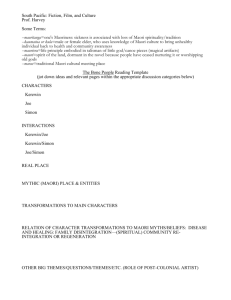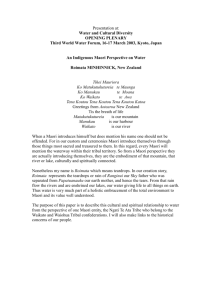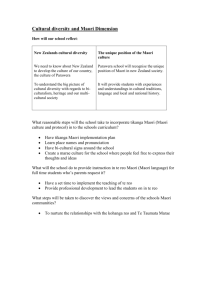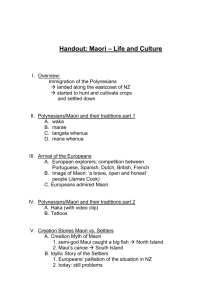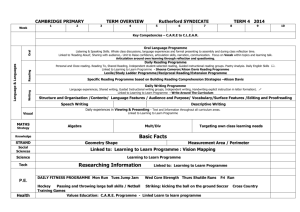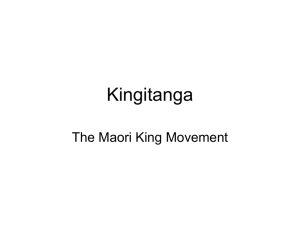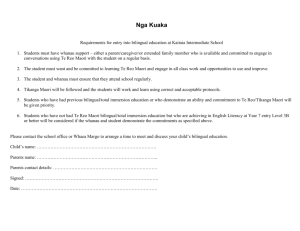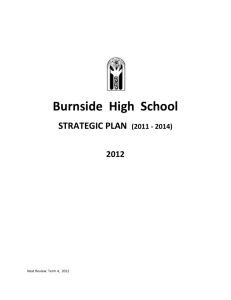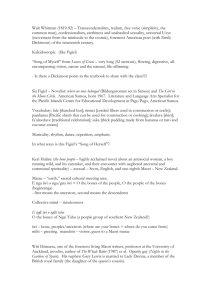'by Maori, for Maori' INDIGENOUS HEALTH IN NEW ZEALAND:
advertisement
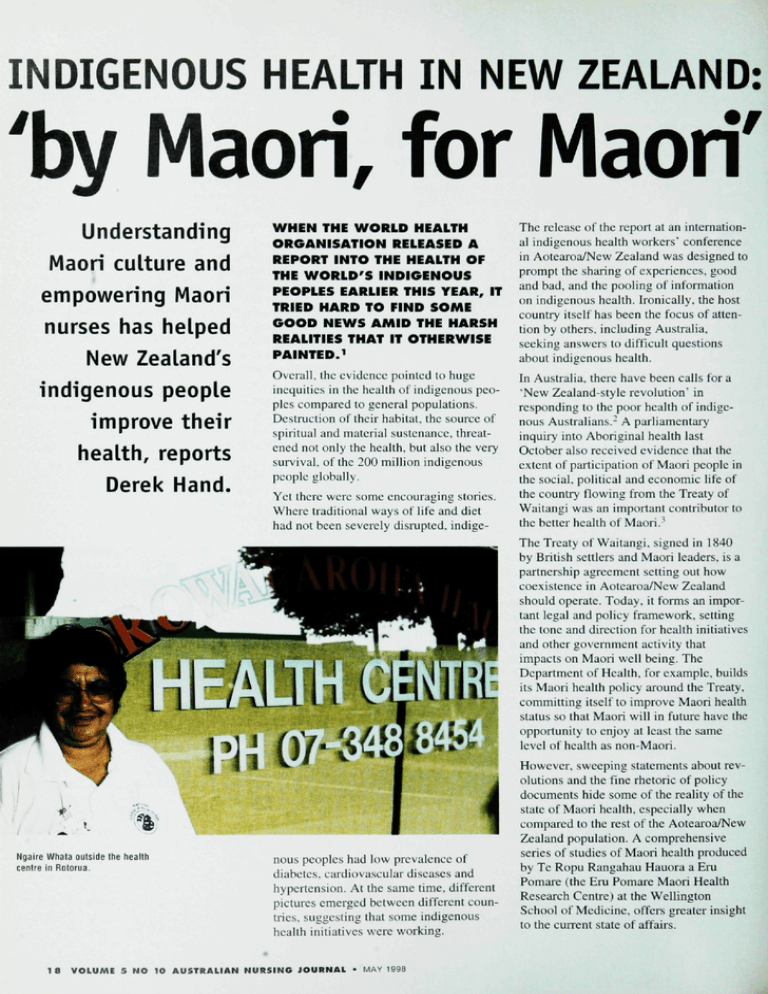
INDIGENOUS HEALTH IN NEW ZEALAND: 'by Maori, for Maori' Understanding Maori culture and empowering Maori nurses has helped New Zealand's indigenous people improve their health, reports Derek Hand. WHEN THE WORLD HEALTH ORGANISATION RELEASED A REPORT INTO THE HEALTH OF THE WORLD'S INDIGENOUS PEOPLES EARLIER THIS YEAR, IT TRIED HARD TO FIND SOME GOOD NEWS AMID THE HARSH REALITIES THAT IT OTHERWISE PAINTEDJ The release of the report at an international indigenous health workers' conferenee in Aotearoa/New Zealand was designed to prompt the sharing of experiences, good and had, and the pooling of information on indigenous health. Ironically, the host country itself has been the focus of attention by others, including Australia, seeking answers to difficult questions about indigenous health. Overall, the evidence pointed to huge inequities in the health of indigenous peoples compared lo general populations. Destruction of their habitat, the source of spiritual and material sustenance, threatened not only the health, but also the very survival, of the 200 million indigenous people globally. In Australia, there have been calls for a "New Zealand-style revolution' in responding to the poor health of indigenous Australians.- A parliamentary inquiry into Aboriginal health last October also received evidence that the extent of participation of Maori people in the social, political and economic life of the country flowing from the Treaty of Waitangi was an important contributor to the better health of Maori.' Yet there were some encouraging stories. Where traditional ways of life and diet had not been severely disrupted, indige- The Treaty of Waitangi. signed in 1840 by British settlers and Maori leaders, is a partnership agreement setting out how coexistence in Aotearoa/New Zealand should operate. Today, it forms an important legal and policy framework, setting the tone and direction for health initiatives and other government activity that impacts on Maori well being. The Department of Health, for example, builds its Maori health policy around the Treaty, committing itself to improve Maori health status so that Maori will in future have the opportunity to enjoy at least the same level of health as non-Maori. Ngaire Whata oitlslde the health centre in Rotorua. 18 nous peoples had low prevalence of diabetes, cardiovascular diseases and hypertension. At the same time, different pictures emerged between different countries, suggesting that some indigenous health initiatives were working. VOLUME 5 NO IO AUSTRALIAN NUR5ING JOURNAL • MAY 1998 However, sweeping statements about revolutions and the fine rhetoric of policy documents hide some of the reality of the state of Maori health, especially when compared to the rest of the Aotearoa/New Zealand population. A comprehensive series of studies of Maori health produced by Te Ropu Rangahau Hauora a Eru Pomaie (the Eru Pomare Maori Health Research Centre) at the Wellington Sehool of Medicine, offers greater insight to the current state of affairs. In the third of its reports, covering the period 1970-1991,-^ the cetitrc notes that death rates for Maori from almost all major causes have indeed continued to decrease, but with some important exceptions. Among these arc high rates of sudden infant death syndrotne among Maori infants, youth suicide (paiticularly among young Maori males), homicide and violence, and motor vehicle accidents. Although life expectancy at birth tor Maori has certainly improved in the last 50 years, it has not improved as much as nonMaori. 'At present the difference in life expectancy remains static,' the report states. It also stresses the link between health and socioeconomic factors such as income, employment, education and housing. 'A review of these indicators for the last decade show that Maori have become relatively worse off compared to the non-Maori population,' it notes. This is evident in figures from the 1996 census, which show that the median annual income for Maori men aged 15 years and over was NZ$16,000, eompared to NZ$22,000 for all men in Aotearoa/New Zealand. For women, the figures were NZ$11.200 and NZ$12,600 respectively. GIVING VOICE TO MAORI NURSES Where there has been success in improving Maori health, a great deal of credit can be claimed by Maori health professionals themselves, ineluding nurses, despite their relatively small numbers. Of more than 28,000 Registered Nurses working in Aotearoa/New Zealand in 1994. only 2.8% (780 nurses) identified themselves as Maori (another 1.1% identified themselves as Pacific Islander, and 92.1% were European/ Pakeha).^ A slightly larger proportion of Enrolled Nurses identified as Maori (8% of the eounlry"s 6552 Enrolled Nurses), but there were fewer midwives (1.97r of the country's 3482 midwives identified as Maori). Giving a voiee to these nurses" views on Maori health is the National Council of Maori Nurses. Formed in 1982 and now representing more than 1000 members, the council is governed by a national executive, and its work is framed within a fomial constitution. Members sit on special subcommittees that bring together nursing and midwifery expertise across a range of portfolios, including mental health, family health, child health, care of the elderly, midwifery, smoking and health promotion. 'Our job is to work at the coalface," said Ngaire Whata. the council's national president, during a break from volunteer nursing duties at the indigenous health workers' Ngaire Whata (left) and Millie Heke undertaking volunteer nursing duties at the international indigenous health workers conference argued that prescribing rights were particularly important for nurses working with rural iwi (tribes), where they needed to be equipped to deal with a broad range of health problems. More broadly, within the nursing profession itself there is acknowledgment of the need for greater understanding of and other community services. It operates a 'purchaser/ provider' split, where funding authorities (the "purchaser") contract with clinics and other programs (the "provider') for health services. In some instances. Maori act as co-purehasers in this system, effectively allowing them greater autonomy in deciding the shape of health care for Maori within fixed budgets. Of the different 'providers' of health care to Maori people, some are described as being 'by Maori, for Maori" (a term used by Maori groups to underline their strengths, and by govemment funding agencies conference. 'The council is as a category in their formal Maori culture and traditional owned and controlled by Maori values. This is reliected in a accounting and reporting sysnurses and for Maori people, so revamped nursing curriculum tems). The Korowai Aroha we can make our own deci("Cloak of Love") health centre that requires all nurses to be sions and set our own policies in Rotoma is an example of a tutored in the Treaty of on the health of Maori. It has service opeiated by Maori Waitangi and in Maori cultural given us the opportunity where interpretations of "health". This nurses lor Maori people. we can set the scene for the Catering for a Maori populaso-called "cultural safety' future health directions of tion of about 22.000 in the area (whakaruruhua) component of Maori." around Rotorua. the clinic was the national nurse education Working at the coalface is also courses was introduced in 1992 set up with government funding in 1992 by a group of local and is taught in 15 nursing and about lobbying governments over changes that might lead to five midwifery colleges around Maori nurses. It provides 'culturally appropriate' ciue and improved health Ior Maori. For the country. services and is committed to example, the council has given working with traditional pracKOROWAI AROHA its support to a push for nurse tices. The centre has a full-time prescribing rights, and met Aoteaioa/New Zealand has staff of 15 people, including with the health minister to preembraced the idea of applying lour nurses, five midwives. a sent a Maori perspective. It free market principles to health With our old poople behind us, it gives us a powerful force that allows us to reach Maori. MAY 1998 - VOLUME 5 NO 10 AUSTRALIAN NURSING JOURNAL 19 traditional spiritual healer and a geneiLiI practitioner. It also acts as coordinator for a team of 50 community-based, parttime, paid carers. Korowai Aroha is overseen by a Board of Trustees, all of them Maori, except an accountant member. mation it contains is protected by a guardian. Access to the register ean only be granted by a panel of caretakers. Another important faetor in whether people access primary health care is its cost, especial- exercises. That avoids a lot of injury and is an excellent health gain for us in that area.' Another of the clinic's strengths is its strong links to the Maori community's elders, who offer their support. 'With Ngaire Whata. herself a Registered Nurse, is the centre's manager. 'We see Maori health as having many dimensions,' she said, adding that the centre's strength lay in its ability to view the notion of 'health' through the lens of Maori culture and tradition.'' 'Our people are comfortable in dealing with us.' Staff at the centre see about 11,500 clients a year, and offer a wide range of services, including checks for asthma, diabetes and cervical screening. While deaths from heart disease have gradually declined, cancer has become the leading cause of death for both Maori and non-Maori. Cancer of the breast, lung and cervix are the most common cancers for Maori women. Cervical cancer is three times as common in Maori women as in non-Maori women, a situation which has in tum been linked (at least in part) to the high prevalence of smoking among Maori women. Improved testing and followup is regarded as the best way of reducing the incidence and mortality from cervical cancer. Korowai Aroha underlines the importance of incorporating Maori values into the structure of services such as cervical screening. 'Our women treat the cervix as very sacred. It is a bit different from the Pakeha [Europeans],"she explained. The difference, she said, plays itself out in the greater reluctance of Maori women to come forward for cervical screening. Recognising the importance of privacy, a Maori women's cervical screening register has been compiled and the infor- 20 Australia. CATSIN chair Sally Goold said she was optimistic that nursing education in Australia will successfully take on notions of cultural safety, in turn rectifying the absence of a strong indigenous presence in nursing. 'It would pave the way for reconciliation, for nurses to really examine their feelings and take on the philosophy of reconciliation.'• AUTHOR Derek Hand is a Sydney-based journalist. He travelled to Aoteaora/New Zealand ivith the 199"^ annual award of the Australian Medical Writers' Association. REFERENCES 1 World Health Organisation The Health of Indigenous People. World Health Organisation, Geneva, January 1998, Ngaire Whala with a framed copy ot the Treaty ot Waitangi ly when the 'user-pays' principle is dominant. 'We have to charge people who come to see our nurses,' said Ms Whata. 'We used to only charge a kauhau [donation]. Now we charge NZ$5 for each visit to the nurse or doctor to people with a community services card." The clinic does not eharge for children under six years, and for others, the fee is NZS15. It may not be free, but it compares favourably to a fee of up to $40 that is otherwise charged for a standard visit to a GP. Although its primary focus is on Maori people, the centre does not exclude non-Maori. 'We are also prepared to work outside our region, but only when we are invited," she said. Millie Heke. a nurse at the centre, said education was a large part of the day-to-day work, such as holding stop-smoking clinics on local marae. the traditional Maori meeting places. 'In sports, we see that a iot of people are now doing warm-up our old people behind us. it gives us a powerful force that allows us to reach Maori,' Ms Whata said. Staff recently reported a drop in the number of older people attending the clinic. 'They were busy doing line dancing!" Millie quipped. 'We had told them not to sit at home thinking they were going to get sick. We told them to get out and walk and dance and do things.' Acknowledging the particular skills and insight that they bring to their work, the WHO has called for a swelling of the ranks of indigenous health workers. In Australia, that sentiment is echoed by the Council of Aboriginal and Tones Strait Islander Nurses (CATSIN). which was formed in the wake of a forum held last August to fmd ways of recruiting and retaining indigenous nurses. CATSIN has endorsed the Aotearoa model of cultural safety, and has called for its implementation in VOLUME 5 NO 10 AUSTRALIAN NURSINO JOURNAL • MAY 1998 2 In a press statement dated 15 September 1997. the president of the Australian Medical Association, Dr Keith Woollard, described the need for a New Zealand-style' revolution in indigenous health. He added: 'Injust three short decades, the health status of the Maori has improved dramatically. In contrast, the health of Australian Aboriginal people has, if anything, got worse.' 3 Australian Medical Association and Public Health Association of Australia, Submission to the House of Representatives Standing Committee on Family and Community Affairs Inquiry into Indigenous Health 1997. 4 Pomare, E., et al,. Hauora: Maori Standards of Heaith III. Wellington: Wellington School of Medicine, Te Ropu Rangahau Hauora a Eru Pomare, 1995, 5 New Zealand Health Workforce 1994, New'Zealand Health Information Sen/ice, Ministry of Health, 1996, Wellington. 6 For a discussion of Maori health perspectives, see Durie, M,, Whaiora: Maori Heaith Development. Auckland, Oxford University Press, 1994, For more information, contact Sally Goold of the Council of Aboriginal and Torres Strait Islander Nurses on (07) 3408 8199 or Robyn Coulthard, ANF Nurse Advisor, on (03) 9482 2722.
